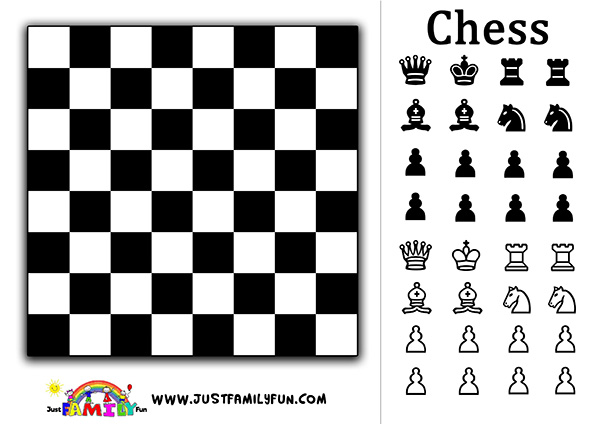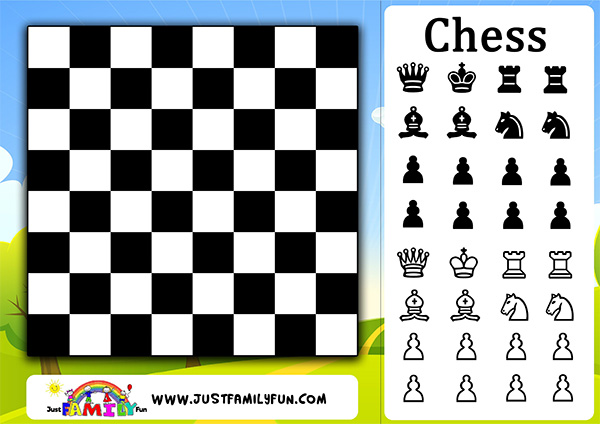
If you’re keen, on playing a game of chess but don’t have a chessboard don’t worry! Just Family Fun has got you covered with our collection of printable chess board templates.
It’s a process. Simply choose the template that catches your attention and embark on a journey of delightful entertainment for the whole family. Whether you’re teaching your children the strategies of the game or having matches with loved ones our printable chessboards add a layer of enjoyment to your leisure time.
Don’t wait any longer. Enhance your family bonding moments, with the timeless charm of chess.

Explore the options we provide with our templates. You have the choice between two versions, each tailored to suit your preferences and requirements. Here’s what you’ll find;
1. Classic Black and White Version;
Immerse yourself in the timeless elegance of a white chessboard design.
This version includes a set of chess pieces that can be easily cut out and utilized.
Enjoy a game of chess in its form with a minimalist touch that reflects the rich history of this ancient game.
2. Vibrant Full Color Version;
Delight in the vividness of a full color chessboard that adds a dynamic to your matches.
Similar to the white version this variation also comes with a set of chess pieces, for your convenience.
Immerse yourself in an aesthetically pleasing experience that captures attention and brings extra excitement to your games.
Additional Tips and Recommendations;
To enhance durability and prolong its lifespan we suggest laminating your chosen template. This protective layer not ensures longevity. Also preserves the quality of the template over time.
If your chessboard shows signs of wear and tear there’s no need to worry.
With our user approach printing a replacement becomes effortless. Embrace the versatility of our options. Customize your chessboard to match your style. Indulge, in the elegance of black and white. Explore the vibrant world of full color designs with our printable chessboard templates. Enhance your chess playing experience by adding a touch of creativity and practicality to every game.


Chess is a game that stimulates your mind and encourages thinking. If you’re an enthusiast to learn the ins and outs of chess you’ve found the perfect resource! This guide will simplify the games fundamentals into to follow steps allowing you to embark on your chess journey with confidence. So lets delve into the captivating world of kings, queens and pawns!
Step 1; Board Setup;
To begin position the chessboard between you and your opponent. Ensure that the bottom right square is light colored. Each player should have a square on their side. The chessboard consists of 64 squares arranged in an 8×8 grid.
Step 2; Introduction to Chess Pieces;
In chess there are six types of pieces; King, Queen, Rook, Bishop, Knight and Pawn. At the start of the game each player possesses a total of 16 pieces arranged as follows;
Back row (closest, to you); Rook, Knight, Bishop, Queen, King, Bishop
Step 3; How the Chess Pieces Move;
King; The king can move one square in any direction.
Queen; The queen has the freedom to move diagonally horizontally or vertically as far as desired.
Rook; The rook is allowed to move vertically without any restrictions, on distance.
Bishop; The bishop can move diagonally in any direction for any number of squares.
Knight; The knight moves in an L shape by moving two squares in one direction and then making a right angle turn to move one square. It can also move vice versa.
Pawn; A pawn moves forward one square at a time but captures diagonally. On its move it has the option to advance two squares.
Step 4; Objective of the Game;
The ultimate objective in chess is to checkmate your opponents king. This means putting their king in a position where it cannot make any moves without being captured.
Step 5; Moves;
Castling; Castling is a maneuver involving the king and one of the rooks. In this move the king shifts two squares towards the rook while the rook jumps over the king. It is a strategy, for safeguarding your king and connecting your rooks.
En Passant; En Passant refers to a pawn capturing another pawn that has just moved two squares forward from its starting position.
Step 6; Progressing in the Game;
In chess players take turns making moves, with their pieces. It’s important to plan and consider your opponents moves. Keep an eye on protecting your pieces while also seeking opportunities to capture your opponents pieces.
Step 7; Checking and Achieving Checkmate;
Check; When a players king is under threat of being captured it is considered “in check.” The player must make a move to ensure the safety of their king.
Checkmate; When a king is in check and there are no moves to remove it from danger it results in a “checkmate.” The game ends at this point with the player who has been checkmated losing.
Conclusion;
Chess is a captivating game that combines strategy, critical thinking and a touch of creativity. By following these steps you’re well on your way to becoming skilled, at this timeless game. Remember that practice makes perfect! So grab a friend set up the chessboard and immerse yourself in the excitement of this pastime. Enjoy playing chess!
Click here for the complete chess guide for beginners.